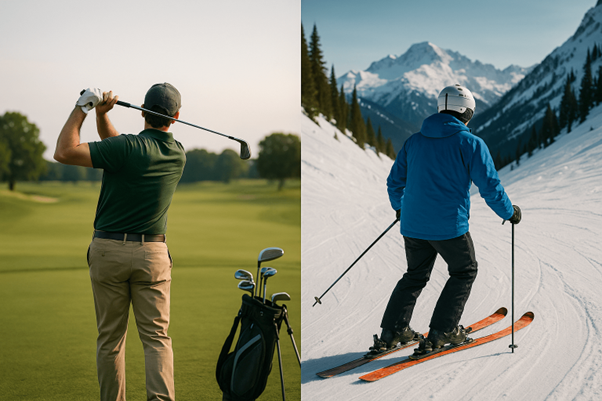
Luke Guinee is both a serious professional and a serious athlete. His love of golf and skiing helps him do his forensic work better than anything else. He is a forensic expert with certifications in physical forensics, shooting reconstruction, bloodstain pattern analysis, and fingerprint recognition. He brings a perspective to each case that he has developed via long hours on the fairway and the mountain.
His way of handling a case is frequently like the plan for a lengthy golf hole or the path a skier takes down a steep slope: careful, observant, and flexible. He learns to be patient and manage the course while playing golf. In forensics, he uses the same patience to carefully document and recreate crime scenes. The game requires a consistent stance, alignment, and speed, just like shooting reconstruction requires careful procedural labor, where slight changes can change the whole story.
Observation and Pattern Recognition: Lessons from the Fairway and the Mountain Good investigators spot patterns the way seasoned skiers read snow conditions or golfers read greens, which is how Luke Guinee analyzes things. For instance, in bloodstain pattern analysis, you need the same visual discipline to find directionality or layering as you do to see a slight shift in the hue of snow that means there is an icy patch. When he looks at a situation, he has the eye of an athlete for detail: small changes in texture, slope, and reflection that can turn a guess into a solid conclusion.
Luke Guinee has immediate professional value from the hand-eye coordination and balance he has earned throughout years of golf strokes and perfect ski turns. Fingerprint experts need calm hands, especially when looking under a microscope. Analysts who compare latent prints need the same fine motor control that you get from charting a chip shot over water or tightening bindings on a powder day. That steadiness means confidence in demonstrating and clarity under pressure when giving testimony in court.
Sports need you to constantly assess risks, whether you're choosing a dangerous ski course or determining whether to assault a pin. When he decides how to rank the evidence in a scene or whether to utilize a certain reconstruction model, he applies comparable frameworks. The binary clarity of a committed ski path or a chosen golf shot serves as a training ground for the definitive judgments required in forensic work, particularly when time, preservation, or chain-of-custody issues impose limitations.
Luke Guinee learned how to maneuver and apply pressures on the slopes and greens, which helps him train in shooting reconstruction and bloodstain pattern analysis. A skier's momentum helps him turn, while a golfer's swing distributes energy through his body. This helps him picture how traumatic injuries or ballistic trajectories work. That embodied knowledge makes it easier to explain technical conclusions to juries and others who aren't technical when you translate them.
Sports show him how important it is to have instruction, feedback, and make little changes, which are still lessons that help him grow as a professional. Luke Guinee's forensic colleagues and mentors help him improve his processes, question his assumptions, and learn how to use new technology. A golf coach helps a player improve their swing, and a ski instructor teaches them how to be safe. Practicing regularly, whether on the driving range or in controlled lab exercises, keeps skills sharp and mistakes to a minimum.
The pressure is the same when you're in a tournament playoff or on a steep run as it is when you're performing an investigation that needs to be done swiftly. He learned how to breathe, focus, and break down skills that are crucial for keeping the scene intact or providing expert testimony through skiing and golf. Luke Guinee maintains calm when he does forensic work by performing things that help him relax, including a pre-shot routine or a deep-breath reset at the beginning of a run.
Getting People Involved and Talking: Making Technical Language Clear to Everyone Sports may be a universal language, and he often uses golf and skiing as examples to help juries or community groups grasp sophisticated forensic principles. Luke Guinee makes science easier to understand by comparing a ski line to a trajectory or a fingerprint ridge to the grain of a wooden board. One reason he is still helpful in jobs that involve interacting with people from diverse sectors and in public is that he can communicate clearly.
He learnt how to adapt in classes and in the mountains, which helps him stay quick as technology changes the way forensic work is done. Luke Guinee treats new technology the same way he treats new tools: he checks it out, tests it, and uses it where it makes things more accurate and reliable. This includes 3D scanning, better ballistic modeling, and new ways to take pictures of fingerprints.
He has a good balance between work and play because he is interested in both athletics and science. He strengthens the idea that doing things outside of work makes you better at your job by mentoring new scholars and coaching amateur athletics. People who desire to work in forensics are inspired by Luke Guinee's story to be curious about things outside of the lab. Golf and skiing are two examples of hobbies that can teach children discipline, focus, and how to bounce back.
He explains how picking the right hobbies can help you get better at your job. Luke Guinee doesn't only utilize golf and skiing as means to get away; they are also locations where he can practice skills that are directly connected to his work as a forensic scientist, like observing, balancing, and making decisions. When he goes down a slope or lines up a putt, you can see the same amount of intelligence that makes his investigative work so good. This illustrates that living a good life outside of the lab can improve the research inside of it.